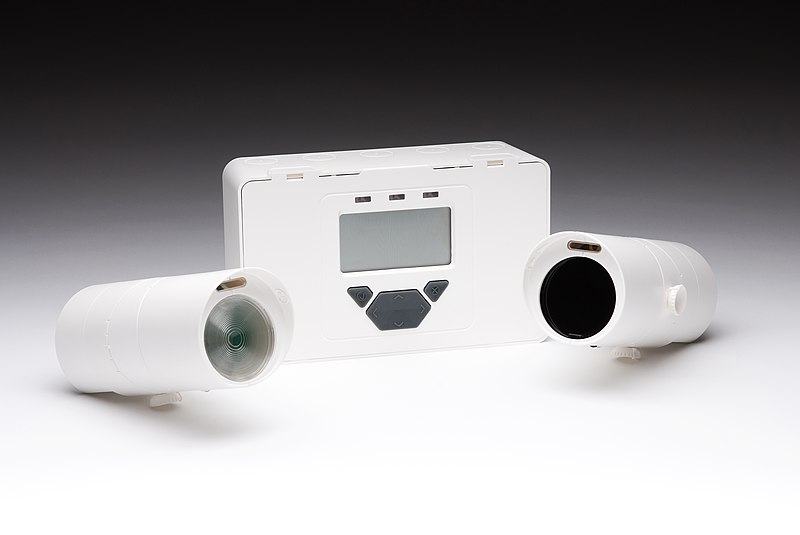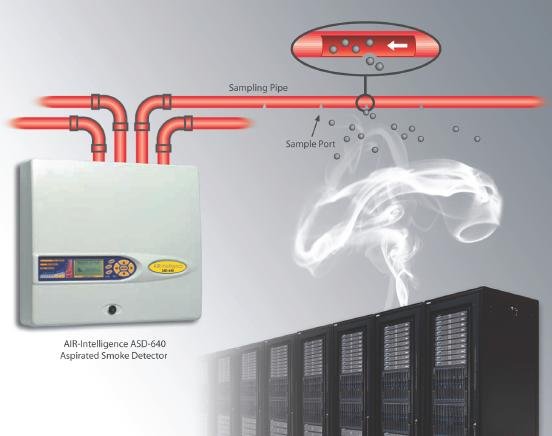Smoke Detectors
What is a smoke detector?
A smoke detector is a device that is used to detect smoke or foreign particles in the air, which are usually an indicator of a fire. Most people probably imagine a smoke detector as a little white box located on the ceiling of your house. Probably something along the lines as this:

Although this is probably the most common type of smoke detector and usually the kind most people are exposed to there are also many other types. The detector pictured above is a residential smoke detector, there are also industrial and commercial detectors as well. The industrial and commercial detectors are usually more expensive and much more complex systems. When smoke is detected the device uses either an alarm, flashing lights or a combination of the two to inform people of the potential danger and allow safe exit.
Types of Detectors
There are two main categories of how smoke detectors actually sense the presence of smoke. The two types are optical detectors and ionization.
Optical Detectors
Optical detectors emit a light source and either measure intensity of the light or an on/off signal. The first type of optical detector is very common inside the home and looks something like this inside:


In the center of the image is the detection chamber. There you can see both the light source as well as the photo diode, which essentially detects the light. If you notice the light source is not aimed into the photo diode. How this works is as smoke enters the chamber, very small amounts of the light are reflected in all directions due to the smoke particles. Some of those reflected beams will now be directed into the photo diode, which then causes the smoke detector to alarm.
The second type of optical detector is an optical beam. This type of detector still uses a light source and a photo sensor but the configuration is not packaged inside a small little box. The optical beam sensor emits a beam of light across the room and directly into the photo sensor. When the smoke starts to fill the room the intensity of the light reaching the photo sensor decreases and triggers the alarm. This type of detector is usually used in industrial and commercial applications such as a large warehouse or storage room where conventional detectors would be impractical or ineffective Webmail.

The third type of optical detector is an air-sampling detector. The air-sampling detector is a system implemented throughout the entire room or building. A series of small pipes run along the ceiling and have small holes in which air is continuously drawn. The air is then brought to a central processing location where optical light (usually lasers) are used to analyze the air for smoke. The type of detector is extremely accurate, with the ability to sense smoke down to 0.005 % obscuration / meter. This extreme sensitivity also allows a multi-stage alarm system to be implemented depending on the concentration of smoke. This type of detector is only really found in commercial or laboratory type environments due to its high cost.


Ionization Detectors
The ionization type detector uses a small radioactive source to supply a small but constant current. When the smoke enters the detector the particulates interfere with the ion exchange and the detector can sense the slight decrease in the current, thus triggering the alarm.

Comparison
Photoelectric smoke detectors respond faster (typically 30 minutes or more) to fire in its early, smoldering stage (before it breaks into flame). The smoke from the smoldering stage of a fire is typically made up of large combustion particles - between 0.3 and 10.0 microns. Ionization smoke detectors respond faster (typically 30-60 seconds) in the flaming stage of a fire. The smoke from the flaming stage of a fire is typically made up of microscopic combustion particles - between 0.01 and 0.3 microns. Also, ionization detectors are weaker in high air-flow environments, and because of this, the photoelectric smoke detector is more reliable for detecting smoke in both the smoldering and flaming stages of a fire. The air-sampling detector is by far the most accurate but clearly not feasible for private consumer use. Below is a table comparing the detection limits of the different types of smoke detectors.
| Type of Detector |
Obscuration Level |
| Ionization |
2.6-5.0 % obs/m |
| Photoelectric |
6.5 - 13.0 % obs/m |
| Beam |
3 % obs/m |
| Aspirating |
0.005-20.5 % obs/m |
Power Point Slides
Smoke Detectors.pptx
Comments (2)
chrisbent said
at 10:52 am on Feb 28, 2013
how long have smoke detectors been around?
alex yetka said
at 12:59 pm on Feb 28, 2013
For the smoke detectors that react when the laser is not picked by the sensor anymore cause the alarm to go off, is there any mishaps that say something other than smoke disrupts the laser and causes the alarm to go off?
You don't have permission to comment on this page.